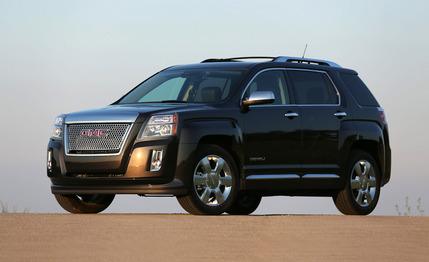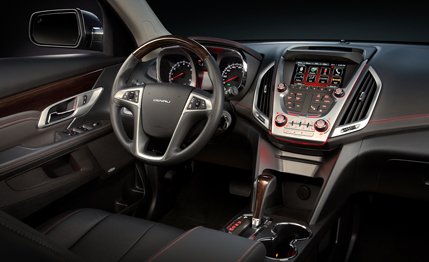
 First Drive Review
First Drive Review
There’s not a whole lot you can do to change the look of a cardboard box, but that won’t deter a resourceful kid. He’ll grab a handful of Sharpies and liberate a few cushions from the sofa, and before you know it—voilà—he’s turned a discarded appliance container into a sophisticated motorcar. GMC apparently followed that same school of thought in bestowing an upgrade on its relatively pedestrian and boxy Terrain crossover. Badge-engineered into a corner—the GMC is pretty well boxed in by the Chevy Equinox on the low end and Cadillac SRX up top—those responsible had to get resourceful. So they went all Mt. McKinley on the Terrain and gave it the Denali treatment.
Denali Looks Not Tied to Newfound Power
Like the average cardboard box, the Terrain has always displayed more creases than curves. The Denali-exclusive chrome “bullet hole” grille bracketed by the body-color fascia gives the flat-faced Terrain a slightly locomotivelike appearance. Satin chrome stands in for the shiny variety on the grille surround, mirrors, rocker moldings, tailgate, and rear bumper. The head- and taillamps, too, get a makeover. To the average observer, the Denali badging itself likely will be the most prominent exterior cue that you just dropped more than thirty-five large on a mid-size crossover.
The bulk of the Denalization takes place inside the vehicle. Red accent stitching abounds, and faux-smoked mahogany accents appear on the leather-wrapped steering wheel and door panels. Embossed Denali logos reside on the seatbacks of the eight-way, power-adjustable (driver and passenger) front chairs, and illuminated front sill plates remind passengers they’re stepping into or out of a Denali.


Although GMC says the 301-hp, 3.6-liter direct-injected V-6 was engineered specifically for the Terrain, this engine is essentially the same as the 308-hp 3.6-liter found in the Cadillac SRX; whether those 7 hp went missing for a genuine reason, such as exhaust restriction, or simply to preserve Cadillac’s vanity is anyone’s guess. The new engine replaces a 3.0-liter V-6 as the optional engine in all Terrains and Chevy Equinoxes. (A carry-over 2.4-liter four-cylinder is standard on all Terrains, including the Denali trim.)
Compared with that 3.0-liter, the extra 37 hp and 50 lb-ft of torque the 3.6 brings to the formerly unswift Terrain are a welcome addition. The AWD version we drove seemed to actually enjoy hustling when called on; we estimate that the 3.6-liter will shave about a second off the 8.4-second 0-to-60-mph time we coaxed from an all-wheel-drive 3.0-liter Terrain. EPA mileage estimates remain the same, despite the additional power, at 17 mpg city and 24 highway for the front-drive V-6 model and 16/23 for the all-wheel-drive version.
Put your foot down to pass, and the six-speed automatic downshifts promptly to keep the V-6 in the sweet spot of its power band, but the accompanying racket is less than seductive. There’s no denying the fury of the mechanical activity going on under the hood; it’s just difficult to get a positive ID on it. To our ears, generic whooshing and whirling sounds overshadow any basso profundo internal-combustion notes that might be struggling to be heard.